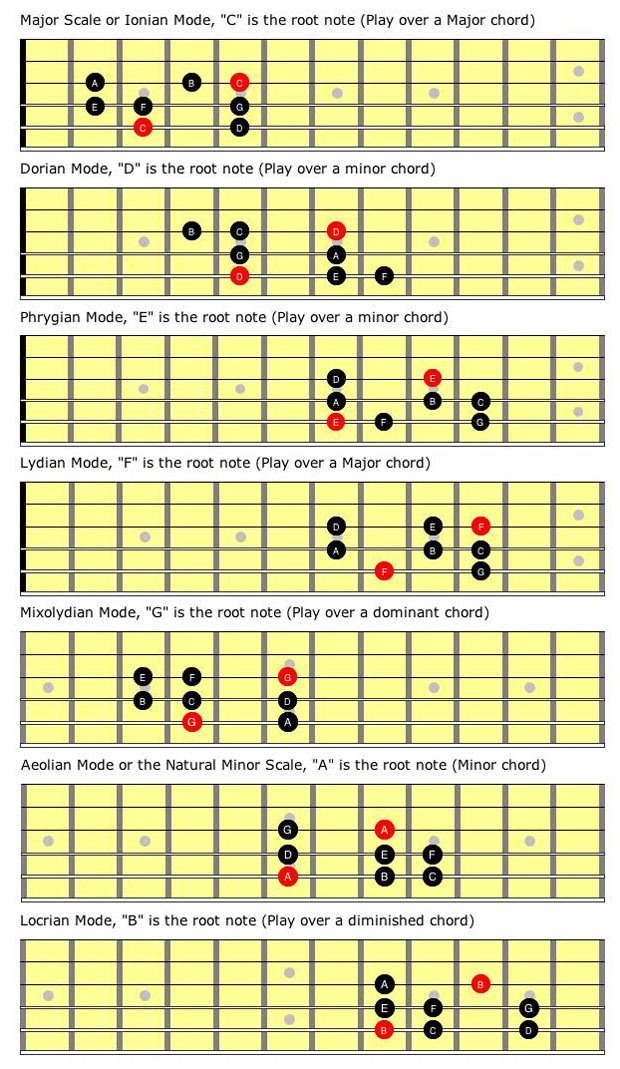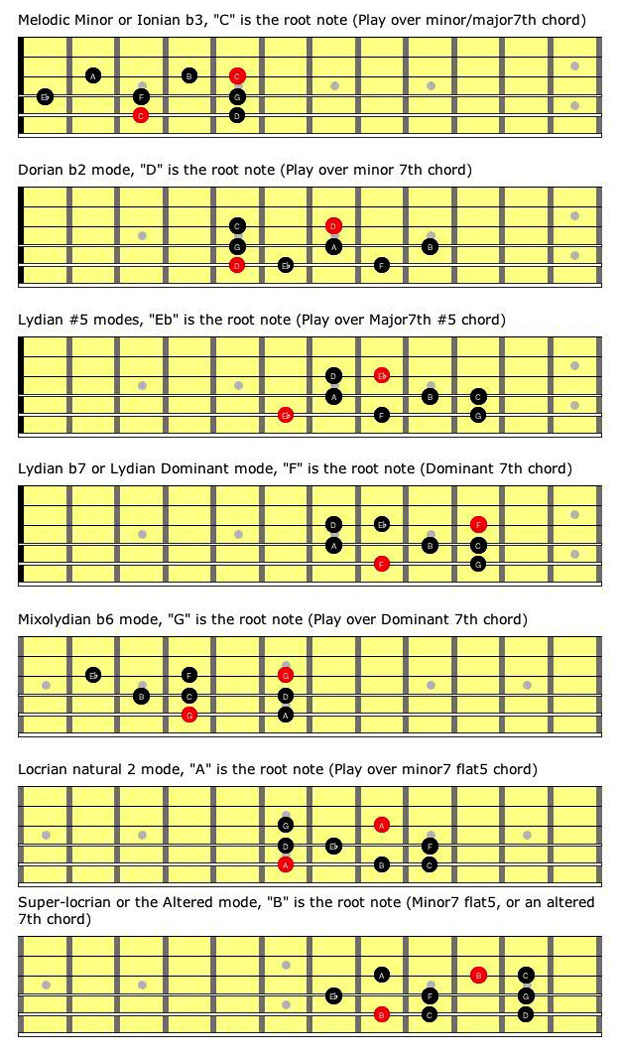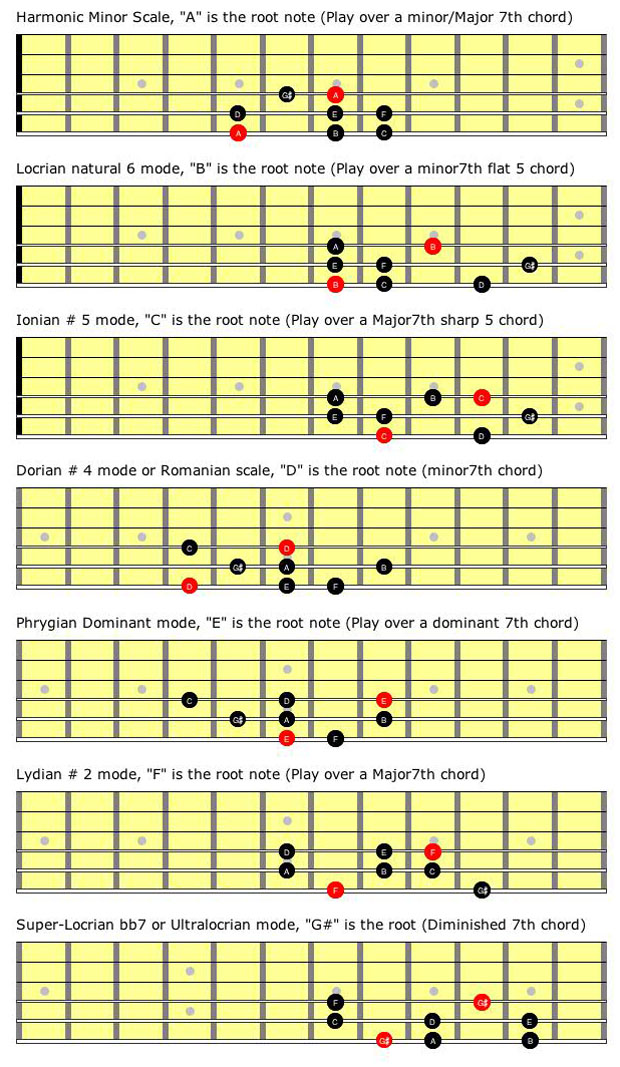Beyond the Fretboard: Knowing "a Ton of Scales" Made Simple, Part 2

In my previous column, we explored how you could visualize four seemingly separate scales as one unified concept.
To illustrate this point, I used the major scale to produce the major pentatonic, the natural minor and the minor pentatonic scales.
How did I do this? Well, it's all a matter of perspective. Simply by changing the tonal center of the given scale, our ears perceive dramatically different flavors and musical moods. This can be an often-overlooked and underestimated approach by some musicians. The important rule to follow with the modal structure is that the tonal shift must happen within the same family of seven notes derived from the parent scale.
This is how I was able to produce four different sounding scales from the same seven notes. The road map for this concept starts with the major scale. The example I left off with in Part 1 was just the tip of the iceberg.
Let's explore what happens when each note of the C major scale becomes the tonal center. We now have seven unique-sounding scales (including the major scale which is also known as the Ionian mode), which are designated by names of Greek origin. Let's look at these examples below:

We won't be diving into the specific flavors of each mode in this column. But, suffice it to say, they all have an interesting harmonic story to tell. So you may be asking, "Is the major scale the only parent scale?" Glad you asked! As it turns out, there are three main parent scales in Western music that help us produce roughly 20 eclectic varieties of musical flavors. These three parent scales are the trifecta of harmonic content for classical, jazz, rock, pop and many other genres.
So we have the familiar major scale, followed by the melodic minor scale and the harmonic minor scale. These three parent scales act as the gatekeepers to an immense plethora of musical variety.
We've already touched on the major scale, now let's look at the C melodic minor scale (On a side note, in Part 1, I notated the flat 3rd note in melodic minor as a D# rather than its correct notation of Eb). You could also refer to the melodic minor as the Ionian flat 3 scale for logical reasons; it only deviates from the C major scale by one note, which is the flat or minor 3rd.
It should be mentioned that in classical theory, the melodic minor scale is meant to be played only in ascending order (from lowest to highest) and then descend with the natural minor scale. But for the purposes of this column, we'll use the jazz world's approach, which plays the same scale both ascending and descending. Because of this, it is also called the jazz minor scale.
By using the modal approach and shifting the tonal center to each individual note, we can produce the following scales:

Admittedly, it might take some time for your ears to acclimate to these scales, especially if you're mostly a rock/pop listener. I am not even completely comfortable with all of the harmonic colors produced by the above scales. But definitely mess around with them, you might be inspired to write some unconventional guitar solos. To help you with these new sounds, I have provided a chord you can play under each particular scale. Obviously this will not tell the whole tale of their melodic potential, but it's a good start.
The final parent scale we'll be looking at is that of A harmonic minor. You might be wondering why I chose to use the note of A as the tonic for this scale as opposed to C, like the other two. Simply because the A natural minor scale (or Aeolian mode) is relative to the C major scale, meaning they share the same seven notes. So the harmonic minor is almost identical to the natural minor except that its 7th note is raised by a half step.
The harmonic minor scale has a somewhat classical sound that might be familiar to metal fans. Another noteworthy scale found within harmonic minor is Phrygian dominant, which also is used in certain genres of metal and has a more Middle Eastern sound. Here are all eight scales (including harmonic minor) shown below:

Another interesting thing you might notice is how all of these modes/scales are named. Much like the intervallic system, the modal system is all based around the major scale and its modes. For example, the second mode in melodic minor happens to be almost the same as the Dorian mode, except the second note is a half-step lower. So we call this mode Dorian flat 2 (or Dorian flat 9).
There you have it. We have 21 completely unique, harmonically diverse scales that can really propel your playing to the next level. To be clear, this number can be considered even higher when you realize each scale has a pentatonic sequence found within.
To wrap things up, in Part 1 of this column, I began by conveying my belief that to be a great guitarist you don't have to know many scales. Rather, you should know a few scales very well. This is something I still believe and will continue to communicate to others.
But there shouldn't be a line drawn in the sand between those of us who know a ton of scales and those of us who only know one or two. This is similar to the constant battle between players who swear by theory and those who believe it over-complicates the fun of creating music. This is a false choice. Real musical freedom is in doing what you want to do with the information provided. You might gravitate toward only one of the 21 scales I've shown you — and that's awesome! Dissect that one scale and make it your own.
My main intent with this column is to demystify the concepts of parent scales, modes and tonal centers so you can grow as a musician. I grew by leaps and bounds just from becoming aware of these concepts, and I hope you do too.
Chris Breen is a New Jersey-based guitarist with 14 years of experience under his belt. He, along with his brother Jon (on drums) started the two-piece metal project known as SCARSIC in 2011. Due to a lack of members, Chris tracked guitars, bass and vocals for their self titled four-song demo (available on iTunes, Spotify and Rhapsody). They have recently been joined by bassist Bill Loucas and are writing new material. Chris also is part of an all-acoustic side project known as Eyes Turn Stone. Chris teaches guitar lessons as well (in person or via Skype). If you're interested in taking lessons with Chris, visit BreenMusicLessons.com for more info.
Get The Pick Newsletter
All the latest guitar news, interviews, lessons, reviews, deals and more, direct to your inbox!
“There are so many sounds to be discovered when you get away from using a pick”: Jared James Nichols shows you how to add “snap, crackle and pop” to your playing with banjo rolls and string snaps
Don't let chord inversions bamboozle you. It's simply the case of shuffling the notes around







![Joe Bonamassa [left] wears a deep blue suit and polka-dotted shirt and plays his green refin Strat; the late Irish blues legend Rory Gallagher [right] screams and inflicts some punishment on his heavily worn number one Stratocaster.](https://cdn.mos.cms.futurecdn.net/cw28h7UBcTVfTLs7p7eiLe.jpg)


